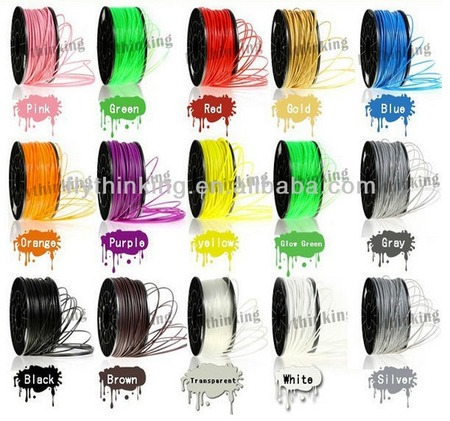Owners of personal 3D printers require a supply of plastic filament to fuel their favorite device, but where should they purchase it from?
The obvious and first answer is to simply buy it from the manufacturer of your printer. Most manufacturers, especially the larger manufacturers, often have a division that will sell you a selection of filament spools that “fit” your machine, both physically and chemically. The thinking is that by controlling the chemistry of the filament, they can tune the machine and software configuration to extrude optimally.
But often the cost of filament is high – and sometimes very high if it’s packaged in proprietary containers. So are there alternatives?
Possibly.
Aside from the usual sources, we took a quick look at going direct to China for filament using the popular manufacturer sales site, Alibaba. As an example, we checked out the offer from Guangzhou Flythinking Macromolecule Material Limited, who sell a variety of ABS and PLA filament.
For PLA, GFMML sells 1kg spools at a cost between USD$5 and USD$15 per spool. This is significantly less expensive than conventional sources, who can charge USD$30, USD$50 or more for a 1kg spool of PLA.
GFMML provides volume discounts, with the highest volume receiving the lowest price: USD$5/kg. However, they do offer the ability to purchase a single spool at USD$15. Note: if you’re looking through such offers at Alibaba, be certain to verify the minimum order requirement. Some manufacturers require minimums of quantity 1000, for example. You might order a shipping container of plastic by accident! You’ll also have to pay for shipping and any import duties imposed by your region.
GFMML offers PLA in a decent set of colors, so why not go ahead? There are a couple of potential concerns:
- Color consistency between batches may be an issue. Sure, the filament is only USD$15 per spool, but you might get surprised after loading the next spool.
- Filament diameter should be very consistent to avoid jams. GFMML specifies pretty good characteristics in this regard, but some manufacturers don’t mention it.
- Colors are sometimes implemented with toxic lead-based pigments. You don’t want lead particles floating around your home. Look for a safety statement from the manufacturer.
And if that isn’t enough, you also may wish to support local plastics manufacturers instead of going overseas.
If you can find a manufacturer that provides a safe and consistent quality filament at low cost, that’s should be your choice. But you may be surprised to find that it’s a local manufacturer.


